Basketball Offense - Kansas 2-3 Zone Offense
By Dr. James Gels, from the Coach’s Clipboard Basketball PlaybookDisclosure: This page contains affiliate links, which means that Coach's Clipboard receives a small commission (at no cost to you) if you make a purchase using these links.

The 2-3 zone defense is the most commonly used zone defense, designed to stop the inside game. Good outside shooting can beat this zone, but you still need to get the ball inside, especially late in the game, or when your shooters are not hitting. Presented here are notes from Bill Self, Kansas head coach, discussing 2-3 zone offense.
Coach Self has been head men's coach at the University of Kansas since 2003, after coaching at Oral Roberts, Tulsa, and Illinois. His 2008 Kansas team won the NCAA National Championship and he was named coach of the year. Along with his many other accolades, his Kansas teams have been in the NCAA Final Four and Elite Eight a number of times.

Coach Bill Self
"Stationary" 2-3 Zone Offense
Stationary means that the perimeter players, for the most part, are relatively stationary and move the zone by passing the ball quickly - like a "hot potato". We don't want perimeter players holding or dribbling the ball much. We want quick passing and ball-reversal, in addition to looking inside for our post players. This doesn't preclude a perimeter player from dribble-penetrating a gap. Again, the best shots are usually after a few "sides". Follow the player rotation rules now. Most of these rules govern how post players move.
Pass to the wing
We start with both posts low (diagram A), a 3-2 set. When the ball is passed from the point to either wing, the opposite low post player flashes to the ball-side elbow. Before cutting to the elbow, the post player (here O5) starts the cut and then if the defender is bumping or denying his cut, he seals the defender and could get a lob pass from the wing. But otherwise he cuts to the elbow. In the college men's game, guys are playing above the rim, and the lob pass is a good option, but maybe not as good for younger, shorter, less athletic teams.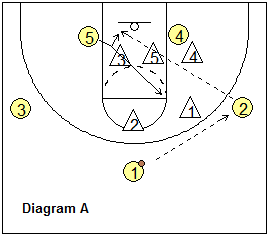
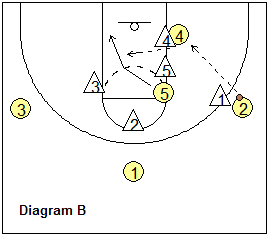

Pass from wing to low post
In diagram B, if the ball is passed into the low post, the player at the elbow (O5) dives down the lane for a possible pass from O4, and then relocates at the opposite low block or short corner.Wing-to-wing skip pass
On a wing-to-wing skip pass (diagram C), both posts cut across the lane to the ball-side.Low post to opposite wing skip pass
Diagram D - if the low post player skip-passes out to the wing or the top, the post player at the free-throw line (O5), makes a "crack-back" block or screen on O4's defender and O4 cuts into the lane (diagram E) for a possible pass from the wing. After screening, the screener O5 seals and cuts to the ball-side block and could be open for the pass from the wing (diagram F).


Point to wing pass with one post player already at the high post
Diagram G - O5 is already at the high post when O1 passes to O3. Here the high post player cuts to the ball-side low block and posts up.
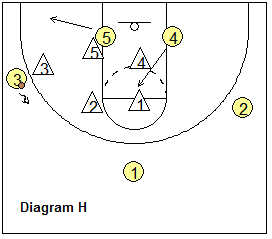
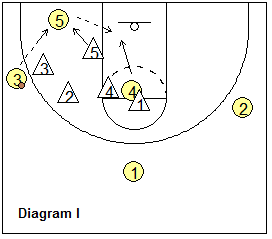
Getting the ball inside via the short corner
Diagram H - if the wing player takes one dribble toward the top, this triggers the ball-side low post player to move to the short corner and the opposite low post to flash to the ball-side elbow (diagram H). Now O5 gets the pass from the wing in the short corner (diagram I), and O4 dives to the basket for a pass from the short corner.Skip pass from short corner to the top
Diagram J - again the skip pass from inside to outside triggers the "crack-back" block ( a post on post down-screen). Here the opposite post O4 makes the crack-back block, and O5 cuts around O4. If O5 doesn't get the quick pass inside, he/she moves to the opposite block or short corner. The screener O4 seals the defender and could get the pass from the top for the layup (diagram K).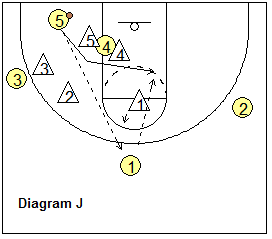
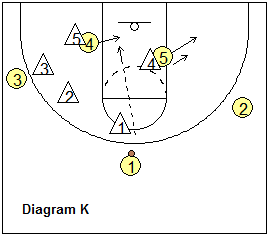
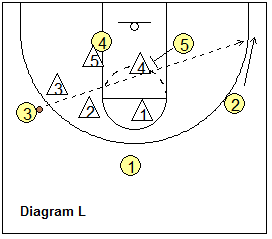
Flash-cut denial - skip pass from wing to corner for a 3-point shot
Finally, diagram L shows the defense over shifted on the ball-side with the ball on the wing (O3). Ordinarily, with the ball on the wing, we would expect the opposite low post O5 to flash to the ball-side elbow. But the defense denies the flash cut. O5 reads this, and instead of fighting with the defender, he/she back-screens the low outside X4 defender. Our opposite wing O2 slides down to the corner and O3 skip passes to O2 for an open 3-point shot from the corner.This concludes the major rules of the "stationary" zone offense. Again, the ball moves the zone (quick perimeter passing), and our post players do most of the moving inside.
The rest of this article is in the Premium Members section or the Playbook download.
Sign up now!
The complete article also includes:
- "Motion" 2-3 Zone Offense
I think both of these zone offenses would work well against not only the 2-3 zone, but also against match-up zone defenses because of the "hi-lo" action that occurs with these offenses. See Coach Bill Self's Zone Offense DVD.
Related pages:
- Kansas Zone Plays
- Zone Offense
- 2-3 Zone Offenses
- 2-3 Zone Plays
- Simple 2-3 Zone Offense
- Stanford Motion-Zone Offense
- 2-3 Zone Offense Drills